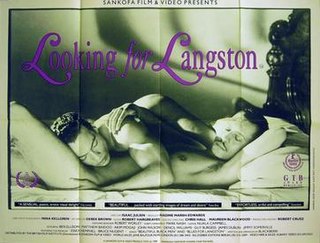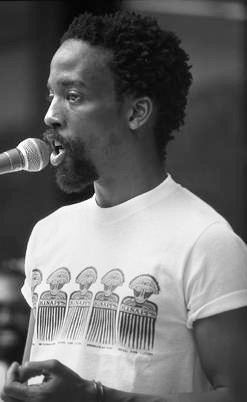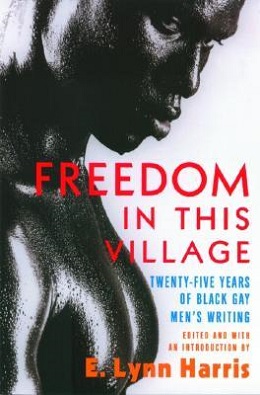
Marlon Troy Riggs was a black gay filmmaker, educator, poet, and activist. He produced, wrote, and directed several documentary films, including Ethnic Notions, Tongues Untied, Color Adjustment, and Black Is...Black Ain't. His films examine past and present representations of race and sexuality in the United States. The Marlon Riggs Collection is housed at Stanford University Libraries.

Paris Is Burning is a 1990 documentary film directed by Jennie Livingston. Filmed in the mid-to-late 1980s, it chronicles the ball culture of New York City and the African-American, Latino, gay, and transgender communities involved in it.

Tongues Untied is a 1989 American experimental documentary film directed by Marlon T. Riggs, and featuring Riggs, Essex Hemphill and Brian Freeman. The film seeks, in its author's words to, "...shatter the nation's brutalizing silence on matters of sexual and racial difference."

Looking for Langston is a 1989 British black-and-white film, directed by Isaac Julien and produced by Sankofa Film & Video Productions. It combines authentic archival newsreel footage of Harlem in the 1920s with scripted scenes to produce a non-linear impressionistic storyline celebrating black gay identity and desire during the artistic and cultural period known as the Harlem Renaissance in New York. The film has a runtime of about 42 minutes.

Essex Hemphill was an openly gay American poet and activist. He is known for his contributions to the Washington, D.C. art scene in the 1980s, and for openly discussing the topics pertinent to the African-American gay community.

Brother to Brother is a 2004 film written and directed by Rodney Evans. The film debuted at the 2004 Sundance Film Festival, where it was awarded with the Special Jury Prize for Dramatic Feature. It went on to play the gay and lesbian film festival circuit where it collected many top festival awards. Brother to Brother was given a limited theatrical release in November of 2004.

William Roscoe Leake, better known as Willi Ninja, was an American dancer and choreographer best known for his appearance in the documentary film Paris Is Burning.
BLK was a monthly American newsmagazine, similar in format to Time and The Advocate, which targeted its coverage of people, events and issues to African-American LGBT readers.
Black is... Black Ain't is a 1995 award-winning feature-length documentary by Marlon Riggs. It explores the multiplicity of expressions of African American identity.
Affirmations is a ten-minute short film exploring black gay sexuality as well as the inclusion of black gays in the black community. The film was produced and directed by Marlon Riggs and released in 1990.

Freedom in This Village: Twenty-Five Years of Black Gay Men's Writing, 1979 to the Present is a 2004 anthology edited by E. Lynn Harris. The book charts the development of black gay male literature from 1979 to the present. The book won the Lambda Literary Award for the Anthologies category at the 2006 Lambda Literary Awards.
Ethnic Notions is a 1987 documentary film directed by Marlon Riggs. It examines anti-Black stereotypes that permeated popular culture from the ante-bellum period until the advent of the Civil Rights Movement of the 1960s.
Assotto Saint was a Haitian-born American poet, publisher and performance artist, who was a key figure in LGBT and African-American art and literary culture of the 1980s and early 1990s.
D.C.Black Pride is the first official black gay pride event in the United States and one of two officially recognized festivals for the African-American LGBT community. It is a program of the Center for Black Equity (CBE) and is also affiliated with the Capital Pride Alliance. DC Black Pride is held annually on Memorial Day weekend.
The African-American LGBT community, otherwise referred to as the Black LGBT community, is part of the overall LGBT culture and overall African-American culture. The initialism LGBT stands for lesbian, gay, bisexual, and transgender. A landmark event for the LGBT community, and the Black LGBT community in particular, was the Stonewall uprising in 1969, in New York City's Greenwich Village, where Black activists including Stormé DeLarverie and Marsha P. Johnson played key roles in the events.
Donald Cornelius Belton was an openly gay African-American author, editor and teacher.

Rupert Kinnard also credited as Prof. I.B. Gittendowne, is an American cartoonist who created the first ongoing gay/lesbian-identified African-American comic-strip characters: the Brown Bomber and Diva Touché Flambé. Kinnard is gay and African American.
The National LGBTQ Wall of Honor is an American memorial wall in New York City dedicated to LGBTQ "pioneers, trailblazers, and heroes". The wall is located inside of the Stonewall Inn and is a part of the Stonewall National Monument, the first U.S. National Monument dedicated to LGBTQ rights and history. The first fifty nominees were announced in June 2019 and the wall was unveiled on June 27, 2019, as a part of the Stonewall 50 – WorldPride NYC 2019 events. Each year five additional names will be added.

Blackberri was an American singer-songwriter and community activist. His music focused on issues such as civil rights, LGBT rights, and pollution. After the start of the AIDS epidemic, Blackberri worked in HIV education and prevention in Black communities.
Joseph Fairchild Beam was an African-American gay rights activist, writer and poet.









